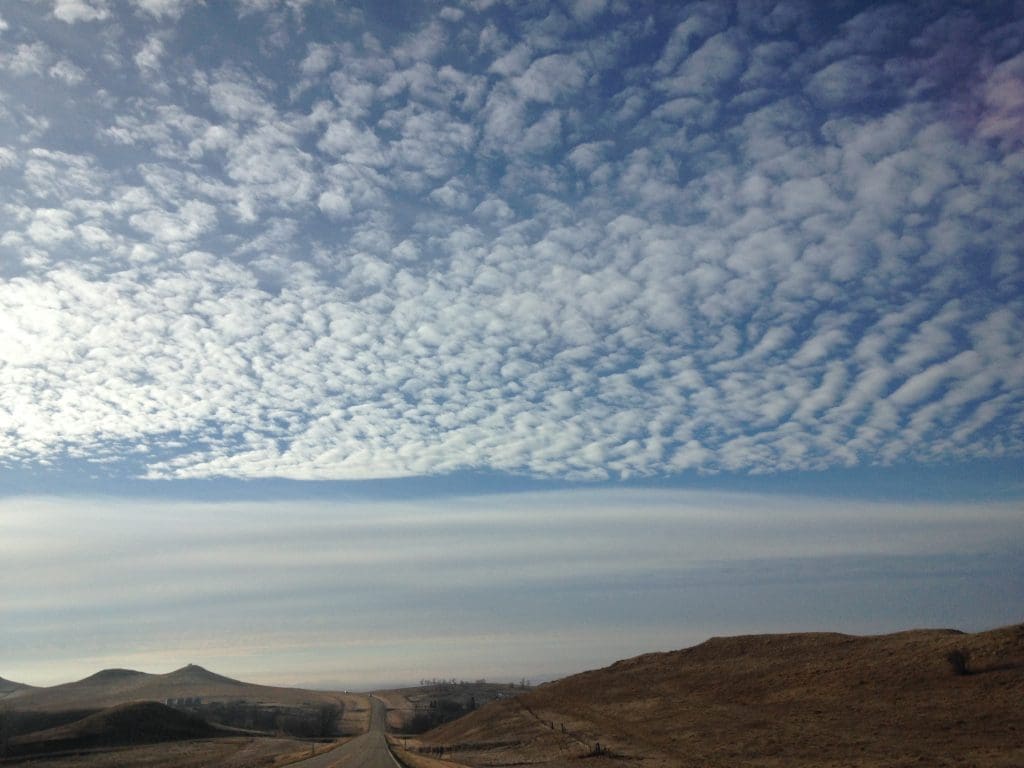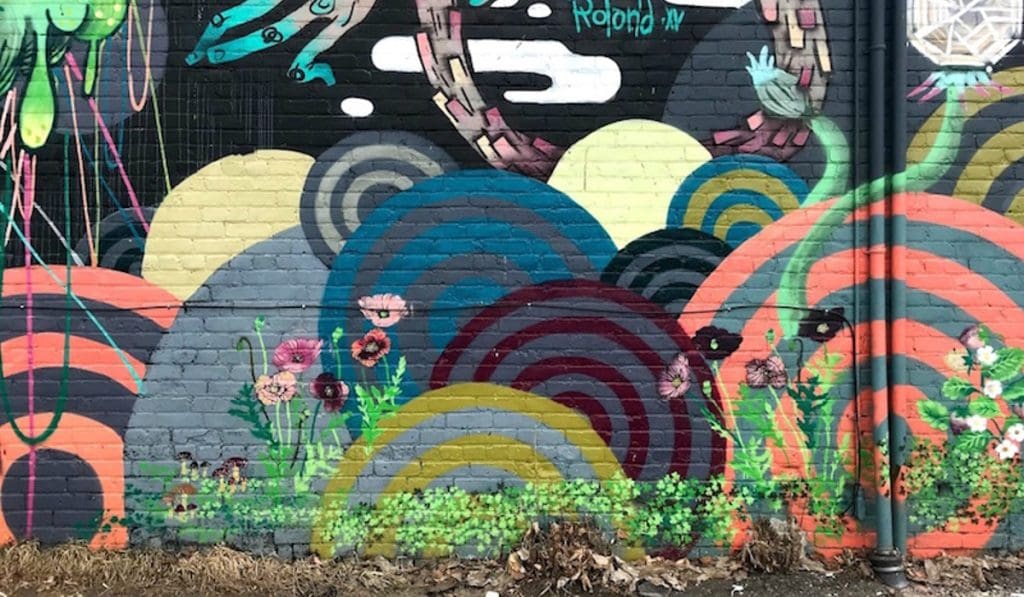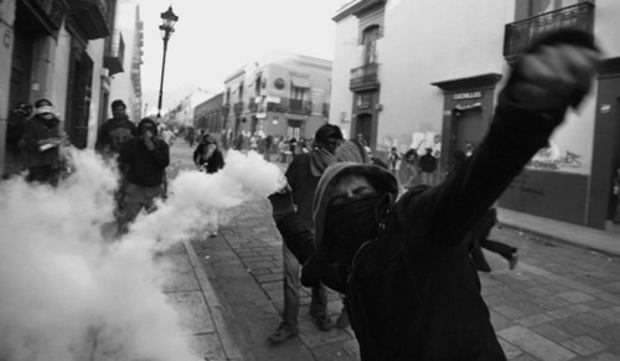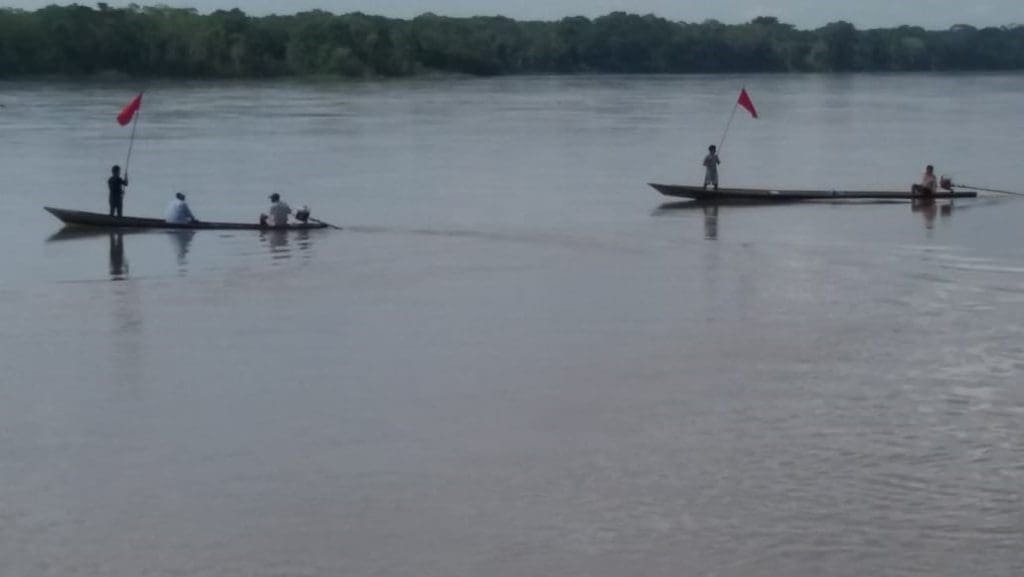Thanksgiving Reflections on Standing Rock
Elizabeth A. Sutton
23 November 2016
A man sits on a hill tending a small smoke pit. The wind is fierce, gusting across the frosted grass and making circles in the dirt. His body is covered in a thick green coat with a hood, in addition to the hat and gloves he has to protect himself from the cold as he conducts his private ceremony.

Standing nearby, I look out over the great expanse of the Missouri. The great river curves and convenes with the smaller Cannonball River. It reminds me of Thomas Cole’s painting, The Oxbow. Like Cole’s painting, the vista from this hill shows the conflict of human presence in nature, the conflict between “development” and sacred origins. To the north, huge derricks with bright lights pollute the vast and clear sky. Turning to the south, from the same spot I can also see a motley array of tipis and yurts holding steadfast, while multicolored tents and flags flap and snap in the wind. Three sacred fires burn continuously in the camps, producing light and heat that infuses the body and illuminates the soul; across the river the artificial bulbs glare maliciously, robotic, mute, and cold.
What is happening on the Standing Rock Sioux Reservation as water protectors continue to fight the construction of the Dakota Access Pipeline has deep roots in the history of the United States, and European colonialism more generally. What I observed in the brief time I was there were things that I see every day elsewhere in the US: deep racism, white privilege, economic inequality, disaffection with authority—all present alongside deeply held religious belief and commitment to mutual assistance.
I can only tell my story, my brief experience. I am privileged to be able to do so. I am white, a university professor, financially secure. There are many others, however, whose stories are not being told, whose voices continue to be silenced, both by force and by simple ignorance, as well as by the power of racist media to ignore. My story, and the very fact that I am able to speak and share it, displays my privilege, my unearned power. While I write, warm and indoors, others gather in freezing cold temperatures and a sub-zero windchill—some now in hospitals after being assaulted by water cannons and concussion grenades—to physically and symbolically stand up for their very existence, their right to live free from oppression and persecution.
Survivance, a term coined by Gerald Vizenor (White Earth Anishinaabe), is “an active sense of presence, the continuance of native stories, not a mere reaction, or a survivable name. Native survivance stories are renunciations of dominance, tragedy and victimry.”i Every living being resists oppression, violence, death; we each search for places of belonging, love, and safe spaces to communicate our respective truths. We gain strength and voice from each other by sharing our stories.
The glossing of the mainstream media with the blatant lies told by Morton County Sheriff’s Department and the abuses of human rights in North Dakota is as shocking as the recent events themselves. There is a deep irony in the fact that a few days before the US holiday commemorating shared bounty between whites and indigenous people, those people upholding the values of mutual care over economic expediency were assaulted with concussion grenades, rubber bullets, and water cannons. I had left camp just a few hours earlier, and my feelings now intensify with every new report: I am angry, worried, ashamed; I feel helpless because I was not there, I am not there. But I can share my story, to elevate others’.
The Pilgrimage to Sacred Stone Camp
Gretta and I drove through a blizzard in Minnesota to arrive at Sacred Stone Camp, near Cannonball, North Dakota, on Saturday morning, 19 November 2016. It was cold and windy, but sunny. We were greeted at the security guardhouse by two friendly young men who confirmed that we did not carry firearms, weapons, drugs, or alcohol. My vehicle was packed to the brim with donations of coats, sleeping bags, firewood, and construction tools. We had done our homework, and knew what was needed: namely, supplies for winter and skilled labor (I brought supplies, Gretta the skilled labor). The guardhouse itself was in need of more work. When we told the security pair that we had tools and skills, they said one of the carpenters who had been working on the guardhouse had hurt his back, so Gretta’s assistance would be useful there.
We left the chop saw and tools, and drove down the steep dirt hill, past the army-tent kitchen, a half-constructed school, and a few tipis, tents, and shipping containers, to deliver the supplies we had brought at the “manifestation station.” A Native woman greeted us warmly, directing the items to organized piles. “Beauty…thank you…kindly over there.” When I told her we had some Menard’s gift cards (Lowe’s has stopped delivering to Standing Rock because they view the water protectors as “terrorists”), she directed me to another Native woman, even escorting me to her to make sure the cards were safely delivered.
I returned with Gretta to the guardhouse where she began work. Tools were plugged into a single generator, and a wood stove was plumbed in the house, but not yet functioning, as the roof had yet to be completed. She took with her a granola bar and apple, hat and gloves. The sun shone bright, but it was still quite cold, hovering around thirty degrees Fahrenheit.
As I pulled out our tent to set it up, a man in coveralls and a red beard approached and asked if I could jump-start his truck, explaining that he had a meeting to get to at noon. I said sure, and we proceeded to become fast friends. Jason is a carpenter and an intellectual, studying philosophy and political science in Pennsylvania. He is at Sacred Stone Camp with his brother, with the support of Episcopalians who funded their trip there. One of his first questions to me was whether I had read the resource packet about coming to camp. I had. Unsurprisingly, many people arrive with good intentions, but not a lot of awareness.
This was made clear in some of the interactions I observed over a few hours accompanying Jason as he and I attended a media meeting, he obtained a press pass, and checked into “Camp Media” at the reservation community center. Jason modeled awareness, respect, and patience, while some other whites I observed, in their haste to “help,” acted like the Kool-Aid man busting down a wall.
Many people make the journey to Standing Rock, each for her own reasons, some perhaps seeking a home, community, or absolution, others simply wanting to help. Across these layers are the dynamics of society as a whole. There is the expectation and camaraderie of a music festival; the anxiety and confusion of a refugee camp; the intensity and solemnity of a religious place. In cities outside the camps, I sensed suspicion, and was myself slightly paranoid: one is not sure who supports who.
White Privilege and Racism
Jason had asked about the resource materials because the whole premise of the community at the three camps (Oceti-Sakowin, Sacred Stone, and Rosebud) is built on the sacrality of the site the pipeline is intended to cut through. Turtle Mountain is an ancestral burial site. It is this shared sense of the sacred that burns in the fires at each camp, and that has brought so many people to the camps. It is the sacredness of human togetherness. However, ego can get in the way.
At the Oceti camp, while Jason was waiting to obtain his press pass (a simple procedure that allows one to take photos, provides the guidelines for doing so, etc.), I walked to the art tent (as an interested art historian). Along the way, I saw a white woman asking who she should talk to about leading an art workshop. Two Native women were patiently directing her to the art tent. I stopped and told her I was going to the art tent, and we could find it together. As we walked, she told me about her visual storytelling workshops. She wanted to lead these workshops at camp, before Tuesday, and take any paintings back to Washington to be exhibited. While I love the idea of visual storytelling, and believe in the therapeutic potential of these workshops, I thought to myself, “who asked for this? Is this needed or wanted? Who benefits and how?” The art tent was being winterized, and while the volunteers there listened respectfully, I wonder whether the workshops ultimately took place.
When we arrived at Camp Media a little later, we came upon a scene. A young white man was insisting he had the right to plug in and use this space within the community center reserved for press. He was being asked by two women which outlet he worked for, where his credentials were, how long he had been at Sacred Stone Camp, and with whom he had communicated. He had only just arrived, and his argument was that the reservation community center was a community center, and therefore he should be able to partake of whatever he wanted there. His arrogance and refusal to listen to what the women around him were asking and saying about processes underscored a privilege he did not seem aware he had. He assumed that by proxy he was part of the Standing Rock community, and that he could take and use what he wanted; since in principle he supported their cause, that cause was also his.
He finally left in a huff, giving Jason the opportunity to pitch his ideas to the women who were clearly in charge at Camp Media. Jason modeled respect. He did not presume his ideas were good, or wanted. He said he would take responsibility for accomplishing the fact sheets he had in mind. He listened when he was asked to create a write-up and come back Monday. He was welcomed.
For both the art workshop leader and the presumptuous young man at Camp Media, it was clear to me that their intentions, while not bad, were still couched in their own desires. It was all (or mostly) about them. This kind of egocentric mentality and presumption, inculturated as privilege among whites, is all too common. But much more violent, inhumane, and sacrilegious is the racism that undergirds the actions of law enforcement and the courts. The same day Gretta and I left Sacred Stone Camp, water protectors were targeted violently by law enforcement, horrifically and ironically, with water cannons. Water is life, and it can be used to destroy. Militarized humans used water, in freezing cold temperatures, to attack other humans protecting clean water on Sunday, 20 November (Jason and his brother were on the front lines and are among those who have posted videos from the scene on Facebook).
It is telling that statements from the Morton County Sheriff’s Department are contradictory. At first, they denied the use of water cannons entirely. Then they suggested water was used to suppress “riots.” Later, the Sheriff’s spokesman indicated that the water was used to put out fires (any dangerous fires were those they themselves had created, for example with the completely careless use concussion grenades. Fire and smoke are sacred to water protectors and obsessively well-tended—and many of their fires on this night were being used to warm soaked and hypothermic people after the initial water attacks).
Having just been at the camp, I know that the people on that bridge were not “rioting.” Every day at Oceti, there are organized meetings and trainings for direct action. White boards around the camp explain the principles of nonviolence. The actions are planned, peaceful, and the rules clear: no weapons, no children; to participate, one must have attended training. Law enforcement consistently seem to be the instigators of violence, and consistently hide that they are, in statements and by deception. Their planes and helicopters and those of Dakota Access fly low over the camps, often at night, with hidden identifiers, against FAA regulations.
Violent institutional racism has a deep history in this country. It should not take any more than a basic knowledge of US history to recall where else water hoses were used by law enforcement against human beings fighting for their civil rights. Similarly, the experiences of those who have been arrested vary widely depending on their race. While I did not participate in direct action nor was I arrested, the stories I heard were consistent in the racist themes throughout. Namely, white activists are treated very differently than Native activists, from the moments of direct action themselves, through court hearings, to imprisonment and release. Some whites report being passed over for arrest; one man spoke of being arrested in a prayer circle with Natives, only to receive minimal misdemeanor charges while the Native activists he was with were charged with felonies. Natives report being jailed separately, and in worse conditions than whites. It is striking that no legacy news outlet or established human rights institution is in North Dakota investigating such stories. This inaction confirms the pervasive racism and silencing that white dominance reproduces.
This violent institutional racism parallels what is happening everywhere in the world, and what is being combated by people in movements across the world, exemplified in the United States by the water protectors at Standing Rock and activists with Black Lives Matter.
Disaffection and Community
I gave a ride to two white twenty-somethings calling themselves Vision and Sky, who told me about their journey to Oceti. They described sleeping in Walmart parking lots on cardboard, being harassed by police in Los Angeles, and having finally found a sense of home at Oceti. After they left, I mused about the different trajectories our lives held. There is no rational reason that I should have the gifts I do, the cultural, educational, and financial capital I do, while their life paths may not have provided such gifts. It has never been an equal playing field. Yet there we were, together.
What I observed at and around Standing Rock is symbolic in the sense that so many people—white, Native, young, poor—are disaffected, disenfranchised, alienated, and seek a sense of purpose. They seek empowerment through finding community in caring for each other and in direct action. Any direct action and act of solidarity and sharing thus matters. It is infused with meaning, because the act of kindness itself is an assertion of power—the power in togetherness—and thus each action empowers those who have been left out in this increasingly unequal society.
Individuals support with donations, giving rides, sharing food. Young warriors on the front lines stand together not only to battle a pipeline, but to demonstrate, together, and find strength in solidarity. Their direct actions expose the institutionalized and condoned violence and racism in this country: the militarized police, the courts, and the media, all of which the enfranchised elite control and have allowed to continue because to disrupt the status quo would be to disrupt the very system that gives them power.
Sacred Unity
We are in a moment of crisis. The feelings of disaffection and hopelessness that lead people to participate in resistance at Standing Rock are similar to those that propelled a bigoted fascist to a position of terrifying structural power in this country. However, the deeply-held belief in human dignity as being stronger than economic gain and systemic power sharply separate Trump supporters from water protectors. The white privilege I witnessed at camp, the multitude of homeless drifters there, the sometimes discordant interactions between people at camp: these are consequences of an unjust, unequal system many have inculturated.
Communication is key; not only between young warriors and elders, whites and Natives, but also water protectors and those outside of camp. There are many myths that we must together combat with clear counter-messages. We can only learn these myths by listening to those with whom we may disagree. For example, a farmer at a Bismarck laundromat told me he had heard that protesters were being paid $36 an hour. While the farmer was anti-corporation, he also had a strong loyalty to the police in his community. And I wonder: what is being told to the police men and women themselves?
Economic inequality and racism breeds suspicion and division. Division distracts us and is used against us all. If we do not reach out, we too, become insulated and separated from the values we may share with farmers and police, pipeline workers and Natives. If the function of law enforcement under capitalism is based on protecting private property, those values are in direct conflict with the sacred communal values being defended at Standing Rock (I have written about the Dutch-Roman roots of property law in the Americas in my book Capitalism and Cartography in the Dutch Golden Age). To preserve the sacred, the camps and cause are purposefully not commodified. No gear or knick-knacks are endorsed by Oceti-Sakowin.
The protest against the pipeline is about preserving life. It is about protecting water. It is about combating colonial racism and corporate-capitalist power. It is, at root, about upholding the sacred truth of peace and interconnectedness. The protest began to protect a sacred site. The man on the hill conducted his private smoke ceremony in a sacred moment, despite freezing cold wind and light pollution. Sacred fires will burn continuously, as long as those with love in their hearts are physically able to keep that fire tended.
The US has a long history of interfaith dialogue and nonviolent action challenging the institutionalized racism and violence in this country. Two threads dance and weave. It may be that using the language of the sacred will be the way we are able to speak truth to power and unveil the greed that denies love, peace, unity, and the self-determination of people. Indeed, this use of the language of the sacred has brought together protectors and citizens of BisMan (Bismarck-Mandan), as described in a recent letter to the editor of the Bismarck Tribune by a water protector I met. This attempt to dialogue can extend into and be expanded by faith communities throughout the US.
These are complex times, and require complex thinking. One must be able to recognize irony; to call out injustice; to stand with and demonstrate love, sometimes by letting go of one’s own prerogatives. We each must listen. We must engage each other in love, listening. We must hear the myths that are told and share our own stories, our own truths, to combat them. It will be a lot of work, and it will take time. It cannot happen with sound bytes and cowardly epithets shouted out vehicle windows or anonymously tweeted by trolls. Real engagement is sustained, intelligent, faithful, patient, and kind. It is present, continuous, connected, and named. Standing Rock is a metaphor for the world. What is happening there is happening everywhere. How we act there—presently, with a sense of truth and the sacred, or violently, with no respect for each other or life—is and becomes the world itself.
What You Can Do
Educate yourself. Educate others. Share information. Speak your own truth. Listen to others: http://www.ocetisakowincamp.org/ https://nycstandswithstandingrock.wordpress.com/standingrocksyllabus/ https://antidotezine.com/2016/09/27/respect-our-very-bones/
Contact North Dakota law enforcement, the governor, and other states sending militarized police:
http://www.yesmagazine.org/people-power/dial-a-cop-20161031/
Sign the petition to protect water protectors’ civil rights and investigate ND law enforcement:
https://petitions.whitehouse.gov/petition/intervene-protect-civilians-standing-rock-and-launch-federal-civil-rights-investigation-law-enforcement-nd
Write letters to the editor of your local paper.
Recognize your power, and use it effectively. Are you most effective at Standing Rock, or by serving as a conduit of information, or by sharing your wealth? Direct donations to Oceti-Sakowin camp can be made via paypal: paypal.me/OcetiSakowinCamp
Featured image taken by the author; The Oxbow from Wikicommons
i Gerald Vizenor, Manifest Manners: Narratives on Postindian Survivance (Lincoln: Nebraska, 1999), vii.





